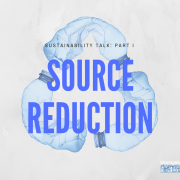Sustainability Talk, Part I: Understanding Source Reduction
Waste. It’s something we think a lot about in the custodial department because, well, that’s a big part of our job. In recognition of Earth Month and Earth Day (April 22), we’ll be focusing on waste and ways that we can better eliminate waste through waste management strategies, such as source reduction. When fully implemented and with full employee engagement, an organization has the resources in place to become “zero waste.”
A waste management strategy typically includes two key parts: 1) Sustainable Purchasing, which focuses largely on the upstream decisions you make on sourcing and source reduction, and 2) Waste Management, which focuses on the downstream decisions you make related to waste disposal. Throughout each element of your waste management program, employees should be engaged. When employees are engaged, your program has better odds for success. For part one of this two-part series, we’ll focus on the sustainable purchasing or the “upstream” part of your waste management program. It’s something ManageMen has been committed to since 1992.
Similar to how we kick off any new (OS1) implementation, an audit is a great way to gain an understanding of your current waste stream. During an audit, you will look closely at the types of waste your building generates, and then see how much of each type of waste is recovered for recycling, or sent to a landfill.
An audit will consist of four basic steps:
- Planning: Identify what you want to achieve from the audit. Include key stakeholders throughout the organization to let them know what you’re doing and why. You’ll also want to gather the necessary materials for the audit, such as bins, protective equipment, etc.
- Collection: Collect the waste and store it in the appropriate bins in a pre-determined location. Waste can be collected and sorted on the same day, or over a period of time, such as a week.
- Sorting: This is the messy part. Go through the waste and sort the materials into various waste receptacles. This might include recyclables, compostables and trash. Record your results by measuring the number of items or the weight of each receptacle.
- Analyzing: Analyze the data. What does it tell you about your current waste management program? What are the opportunities for improvement?
Contact your local solid waste administration for additional audit materials and resources.
A Little More about Using Less
Source reduction through sustainable purchasing practices is an effective waste reduction strategy. Sustainable purchasing means buying products in a way that not only considers the cost of the product, but the environmental, social and health impacts. In the cleaning industry, there’s been a lot of focus on sustainable purchasing practices (e.g. looking for products with third party certifications, renewable resources and local sources). But when it comes to source reduction, we have a lot of room for improvement.
Source reduction, or waste prevention, means finding ways to accomplish the same amount of work while using less product and generating less waste.
According to the EPA, source reduction means “purchasing durable, long-lasting goods and seeking products and packaging that are as free of toxics as possible. It can be as complex as redesigning a product to use less raw material in production, have a longer life, or be used again after its original use is completed. Because source reduction actually prevents the generation of waste in the first place, it is the most preferable method of waste management and goes a long way to protecting the environment.”
What does this mean for you? A few things to keep in mind:
- Buy nice, or buy twice. Oftentimes, when you purchase cleaning equipment and supplies based on price, there’s a good chance that you will end up having to replace the product sooner than you would have to if you would have purchased a better quality product the first time around.
- Consider the packaging and system. We like the PortionPac system because it eliminates redundant supplies, allowing cleaning departments to reduce their cleaning product assortment by as much as 40 percent. It does this with pre-dispensed chemical that users simply pour into their containers.
- Simplify through standardization. When an engineered approach to cleaning is deployed, you are better able to streamline products and procedures, ultimately reducing waste.
- Engage employees. Encourage employees to identify ways they can help reduce waste or reuse items throughout the facility. This will improve the overall success of your effort.
- Avoid purchasing hazardous materials when possible. Enough said.
The theme for Earth Day this year is “End Plastic Pollution.” Of the 9.1 billion tons of plastic produced in the world, an estimated 6.9 billion tons is waste. As we kick-off Earth Month, let’s look at source reduction strategies we can use to reduce the amount of plastic used in our operations.



